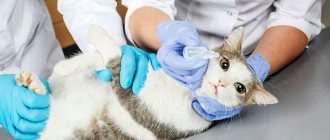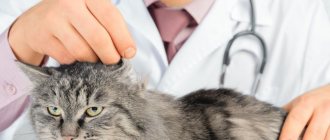Body temperature is one of the main indicators that indirectly indicates the health of a cat. Its significant deviations from the norm require urgent veterinary attention. From the article you will learn what temperature is considered normal depending on the age of the pet, what diseases lead to its increase and decrease, and how to help your four-legged pet at home.
Content
- Normal body temperature in cats
- How to correctly measure a cat's temperature Contact measurement of a cat's temperature step by step
- The main reasons for the rise in temperature
- First aid for hyperthermia
Thermoregulation of cats
Thermoregulation is the ability of animals to maintain body temperature within the most suitable range for life, even if the ambient temperature differs significantly. Cats are mammals. To determine the surrounding temperature, they, like other representatives of this group, have special sensitive organs located in the skin - these are cold and heat receptors.
A receptor is a sensitive nerve ending or specialized cell that converts perceived stimulation into nerve impulses, which, in turn, transmit information to the brain.
The number of cold and heat receptors in cats is not the same. There are much more of the first, and they are not very deep in relation to the surface of the skin; heat receptors are located deeper. This is why almost all cats love warmth and only in extreme heat do they prefer cool places.
Cold receptors are closer to the surface of the skin than heat receptors
Cats have several ways to maintain normal body temperature:
- Sweating. Cats don't sweat like people. There are few sweat glands on their body, and they are not able to remove enough fluid from the body to maintain normal body temperature. Therefore, cats cannot effectively get rid of “excess” heat in this way.
- Licking. For a cat, this is not just a sign of cleanliness, but a necessary procedure for maintaining thermal balance. When licking, a moisture-repellent layer is formed on the fur, which helps maintain the desired body temperature. This procedure also stimulates the glands located deep in the skin, which secrete a special substance - sebum. It reduces the amount of ultraviolet rays penetrating the skin and slows down the release of moisture from the surface of the skin without preventing air from entering. Sebum protects the animal well from moisture and temperature fluctuations in the environment. In winter, licking helps cats retain heat, and in summer, it increases heat transfer by increasing the space between the fur hairs, which opens up air flow to the skin.
- Acceleration of breathing. The main way cats increase heat output. As the air temperature rises, the cat begins to breathe more often. From the outside it looks like shortness of breath: the mouth is open, breathing is shallow. Under normal temperature conditions, a cat makes approximately 30 inhalations/exhalations per minute; in hot weather, their number increases several times.
When severely overheated, a cat begins to breathe with an open mouth, which increases heat transfer in the body.
The listed cooling methods are not always enough. It happens that the best way to avoid overheating is to simply go into the shade. This is what cats do if their health worsens due to the heat.
There are breeds that are more prone to overheating, such as longhaired breeds. They experience heatstroke faster.
Changing body position allows cats to both increase heat transfer and retain heat. For example, in the summer you can often see whiskered animals lying stretched out in the sun, and animals behave the same way near the radiator in winter. But as soon as it gets cooler, the cat immediately curls up into a ball.
Like other mammals, cats can retain body heat by contracting small blood vessels in the skin: in the cold, the vessels narrow, and heat transfer decreases; in heat, they expand, and heat transfer, accordingly, increases. In addition, cats can fluff up, thus increasing in volume. The air gap formed in this case reduces heat loss, and the cat does not freeze. Hairless cats have a more difficult time in this regard; in the cold they freeze very quickly.
By fluffing up its fur, a cat reduces heat loss
The methods of heat regulation described above apply more to adult cats. Kittens do not immediately become capable of independent thermoregulation. At temperatures below 18°C, children may freeze.
Normal body temperature in cats
In adult male cats, the normal temperature is in the range of 37.7-39.4°C (average 38.6°C). This indicator may vary depending on age and some physiological characteristics, but does not depend on the breed - hairless and long-haired cats normally have the same temperature.
Table - Temperature of cats depending on age and physiological conditions.
| Healthy kittens up to three weeks of age | 35.6-37.8°C |
| Kittens over 3 weeks old | 38.2-39.8°C |
| Elderly cats and female cats (over 10 years old) | 37.2-38.9°C |
| Pregnant cats | 38.2-39.8°C |
| Females in heat | 38.2-39.8°C |
In nursing cats, the temperature does not differ from normal healthy animals of their age, and any increase in temperature may indicate mastitis or postpartum complications.
Normal indicators
If a person's temperature is considered normal at 35.9 to 37.2 °C, then in a cat they are always higher - 38-39 degrees. There is an opinion that the normal temperature for representatives of hairless breeds is 42 °C.
In fact, for sphinxes it is the same as for long-haired cats. It's just that your pet's skin always feels hot when touched. It is not surprising, because there is no fur on it.
A slight increase in temperature in cats is always observed during the hot season. Indicators may vary throughout the day. So, during sleep and in the morning after waking up they are lower, but after physical activity, eating and in the late afternoon, on the contrary, they are increased. There's nothing wrong with that.
A temperature jump of 1 degree upward during estrus, pregnancy, childbirth, and also after sterilization or vaccination should not cause concern.
It should be noted that in kittens the mechanism of thermoregulation is formed gradually. In newborns, the readings are considered normal: 35.5 to 36.5 ℃; in babies 1-2 months old, they range from 38.5 to 39.5 degrees. Once the kittens reach 7 months of age, the indicators stabilize.
How to measure a cat's temperature correctly
You can measure a cat's temperature at home with any thermometer designed for humans - contact (mercury, electronic) or non-contact infrared. The most accurate readings can be obtained using a mercury thermometer, but this method is suitable for animals that are calm about therapeutic and diagnostic manipulations. Readings taken with an infrared thermometer are the least accurate, but non-contact readings are sometimes the only possible way to measure temperature in nervous, restless pets. When using electronic devices, you must carefully study the instructions and strictly follow the instructions.
You can measure your cat's temperature yourself at home.
Contact temperature measurement of a cat step by step
- Shake the mercury thermometer so that the mercury column drops to the lower value, the electronic one just needs to be turned on. Lubricate the tip with Vaseline.
- Temperature is measured rectally with the cat lying or standing. To ensure immobility, the cat is secured by the scruff of the neck. To do this, it is better to invite an assistant who will hold the pet. If the animal resists, it is wrapped in a towel, a light blanket, or secured with a special bag.
- Raise the tail and carefully insert the tip into the anus to a depth of about a centimeter (the anus in cats is located above the vulva, just under the tail). During measurement, you should prevent the cat from trying to sit down - this could cause the tip to break off.
- The mercury thermometer must be held for at least 3 minutes, the electronic thermometer must be held until the sound signal.
- Take out the thermometer and record the readings.
After use, the tip of the thermometer should be washed and thoroughly wiped with alcohol to destroy pathogenic flora. If the tip breaks off and remains in the cat’s body, you should immediately contact a veterinarian. Attempting to remove it yourself can lead to severe intestinal injuries.
To measure temperature with an infrared thermometer, the device is brought to the ear from the inside, without touching it, and wait for a sound signal. During measurement, the cat's head must be fixed.
Measuring the cat's temperature with an infrared thermometer
Measuring with a thermometer
As we wrote above, the only accurate method for determining temperature is measurement with a thermometer. For animals, two types of thermometers are usually used: ear and rectal. The earphone is a convenient modern device that is much easier to use. But still, the rectal one is most often used, since for measurements in this case a regular children's model of an electronic thermometer can be used.
How exactly do you take a rectal measurement? The procedure will require two people. One will take measurements, the second will hold the animal and calm it down. If this is standard procedure for your cat, then most likely she will not resist. And if you are doing this for the first time, difficulties may arise. If the animal is aggressive, it is better not to carry out the procedure, as the pet may injure itself and you.
So, take a thermometer. Treat the tip with alcohol, and then lubricate it with Vaseline. Lift the cat's tail and insert the thermometer into the hole using a screwing motion. The insertion depth should be about 2 cm. Now your task is to hold the thermometer until accurate data is obtained. Sometimes after the sound signal you need to hold the thermometer for about 30 seconds and remove it only when the temperature stops rising. Now evaluate the result and wipe the thermometer with alcohol again.
How to measure the temperature in the ear? First you need to calm the animal, show it the thermometer, and give it a sniff. Next, you can take measurements. In principle, even one person can do this. Wipe the tip of the thermometer, carefully insert the thermometer into the ear, but not very deeply. Now wait for the signal and add a few more seconds until the temperature stops rising. Take out the thermometer and wipe it again with alcohol.
Possible causes of hypo- and hyperthermia
Hyperthermia is an increase in body temperature, and hypothermia is a decrease in body temperature. Temperature changes can occur under the influence of cooling or heating of the environment, metabolic reactions in the cat's body. The nervous system is responsible for maintaining normal temperature balance (thermoregulation); central and autonomic disorders can lead to temperature changes.
The main reasons for the rise in temperature
- infectious and inflammatory diseases - panleukopenia, calicivirosis, rhinotracheitis, mastitis, endometritis, cholangitis, pancreatitis, menignitis, abscess and others;
- reaction to vaccination;
- surgery;
- acute poisoning;
- heat damage due to prolonged exposure to the sun, especially in a locked room or car;
- hyperfunction of the thyroid gland (thyrotoxicosis);
- malignant tumor.
Reasons for the decrease in temperature
- hypothermia;
- anemia due to helminth infestation or internal bleeding;
- severe exhaustion;
- thyroid insufficiency (hypothyroidism);
- terminal stage of the disease - cancer, chronic renal failure;
- suffered a serious illness - the temperature may be reduced for several weeks during the recovery period.
With a traumatic brain injury, stroke, or severe stress, body temperature can either increase or decrease.
A cat's temperature is measured rectally using a mercury or electronic thermometer.
Causes of elevated temperature
Hyperthermia occurs due to external and internal irritants, most often under the influence of the following factors:
- Viral diseases. The immune system reacts to pathogenic microorganisms by increasing the temperature, so the bacteria die faster. In cats, panleukopenia (distemper), rhinotracheitis, calcivirosis, and coronavirus are more common. It is possible to protect your pet from these diseases, except for the last one, by vaccination.
- Inflammation. Pathogenic bacteria enter the body when wounds and stitches after injury or surgery heal slowly or are carelessly treated.
- Overheat. Heat transfer is impaired in a stuffy, hot room, car or in direct sunlight. Kittens and older cats are more likely to suffer from overheating.
- Stress. Thermoregulation disorder sometimes begins in stressful situations: when traveling in transport, changing place of residence, visiting a veterinarian.
- A temperature jump of within 1 degree occurs after sterilization and vaccinations. In the first case, this is a reaction to surgery, in the second, it is protection against viruses that enter the body with the vaccine. Increased levels last for 1 day; If the fever does not subside for longer, it is better to take your pet to the veterinarian.
For what symptoms should you measure your temperature?
An elevated temperature may be indicated by hot ears, nose, and paw pads at rest, accompanied by dryness of the nose and redness of these areas. Its decrease, on the contrary, is accompanied by their unnatural coldness and pallor. If such changes occur, the temperature should be measured. Other indications for this procedure:
- copious and (or) purulent discharge from the mouth, eyes, ears, nose, anus, vagina, penis, sneezing, coughing are signs of infection;
- nausea, vomiting, diarrhea - symptoms of inflammation of the digestive system, helminth infestation, traumatic brain injury, overheating;
- pallor of the skin and mucous membranes – observed in anemia;
- convulsions, tremors (trembling of the paws, head, entire body), loss of consciousness - observed with a strong increase or decrease in temperature for various reasons, neurological or thermal damage;
- loss of appetite, weight loss, lethargy, apathy or, on the contrary, anxiety, agitation - can accompany most diseases.
Sometimes a veterinarian may prescribe daily temperature measurements to monitor the dynamics of the disease and monitor the effectiveness of treatment.
What temperature is considered critical?
The critical level is 37C and 40.5C. This temperature is a clear sign of illness and problems in the animal. But what signs accompany all this? The simple method of touching the nose will not help because it is false.
Symptoms of elevated temperature:
- Refusal of food and water.
- The pulse rises to 200 beats per minute. The norm is 150 beats per minute.
- The mucous membranes become inflamed.
- He hides and sleeps longer than usual.
- Vomiting or loose stools are common.
- In the worst cases, the animal begins to become exhausted.
Symptoms of low temperature:
- Lethargy and weakness are noticed, the cat begins to tremble due to fever.
- Sleeps more than usual, begins to hide in warm places and refuses to leave them.
- The wool stands on end to further retain heat.
- Heart rate and breathing slow down.
Kitty
What to do at high and low temperatures
A temporary slight increase in temperature after vaccination or surgery (including castration of a cat, sterilization of a cat) is a normal reaction of the body and does not require veterinary care. Overheating and mild hypothermia can be dealt with independently. You should contact your veterinarian in the following cases:
- with changes in temperature accompanied by signs of any disease;
- with a sharp increase in temperature after surgery;
- with unexplained temperature fluctuations or a stable, prolonged change in temperature without other signs of illness.
Heatstroke, a decrease in body temperature below 32.2°C and an increase above 40°C require emergency contact with a veterinarian. Animals in this condition require intensive therapy, pain relief with narcotic analgesics - normalization of temperature, even with moderate hypothermia, can be accompanied by painful shock.
A temporary slight increase in temperature after vaccination does not require veterinary treatment. help
First aid for a cat at home
Normalizing body temperature does not cure the underlying disease, but improves the pet’s general condition and prevents the development of complications. A critical increase in temperature changes leads to damage to vital organs and systems and disruption of their functions. At home, before visiting a doctor, you can only use physical methods to lower or raise the temperature - cooling measures and warming, as appropriate.
It is unacceptable to lower your cat's temperature with medications on your own.
Antipyretic drugs, which are practically safe for humans, can lead to intoxication of the cat’s body, so their use is possible only as prescribed by a veterinarian. It is strictly forbidden to treat a cat with antipyretics and painkillers of the anilide group (paracetamol, Panadol, Tylenol, Efferalgan, acetaminophen and others) - they lead to severe hematopoietic disorders and the death of the animal.
First aid for hyperthermia
Cooling measures are required for cats with temperatures above 39.4-40°C; at lower temperatures they can lead to hypothermia. In case of heat injury, one of the most effective methods of cooling is wetting the fur and then placing the animal under a powerful fan. You can alleviate the condition at elevated temperatures with ice packs - they are applied to the inner surface of the thighs and neck. This method is convenient for emergency transportation of a pet to a veterinarian. If there is no constipation, diarrhea, or acute abdominal pain, cold water enemas will help reduce the temperature. Another way to eliminate hyperthermia is to wet the paw pads with alcohol.
Ice covering the entire body and general cold baths are not recommended. They cause a narrowing of peripheral vessels, which contributes to the flow of “overheated” blood to the internal organs and their further damage.
If the temperature drop is insignificant, it is enough to wrap the cat in a blanket
First aid for hypothermia
For a cat with a slight (up to 32.2°C) decrease in temperature without signs of exhaustion, it is enough to wrap it in a blanket, after drying the wet fur with a towel or hairdryer. If the animal is exhausted or the previous method is ineffective, warm air is blown under the blanket with a hairdryer, and it is better to wrap the animal’s head as well. With a more pronounced decrease in temperature, the animal is covered with bottles of warm water and taken to the clinic.
If a cat that has been exposed to the cold for a long time does not show signs of life, it should be examined by a veterinarian - during an amateurish examination, a living pet in this state is often mistaken for dead. Cats with severe hypothermia should be transported to the clinic carefully, protecting them from shocks - even the slightest mechanical impact can lead to cardiac arrest and death.
In kittens under 3 weeks of age growing up without a mother, their body temperature drops even when kept in a relatively warm room - their body is able to maintain a temperature only 5-7°C above the environment. The nest of such babies should be kept warm at least 29-32°C. The space inside the box can be heated with lamps, hot water bottles wrapped in a towel.
Learning to measure a cat’s temperature and knowing what its changes may be associated with is important for every owner who loves their pet. This will help the doctor quickly determine the diagnosis, adjust treatment in time and maintain the health of the animal.
Reasons for the drop in temperature
With hypothermia, blood flow is directed to the heart and brain, and in other parts of the body is reduced, resulting in a slower metabolism.
Here are the conditions in which hypothermia begins:
- Hypothermia after being in the cold with high air humidity.
- Weakened state: exhaustion from malnutrition.
- Disruption of internal organs: pathologies of the heart and blood vessels, kidneys and liver, endocrine system.
- Viral infections, if the disease occurs against a background of suppressed immunity.
- Blood loss: occurs after serious cuts, surgical operations, but internal bleeding due to bruises, falls, and illnesses is more dangerous. Owners often do not notice this and do not help the pet.
The owner can know for sure about hypothermia; other causes cannot be identified without veterinary education and special examination.











